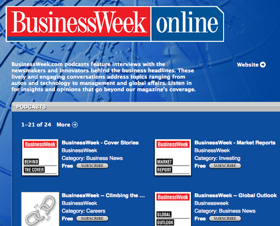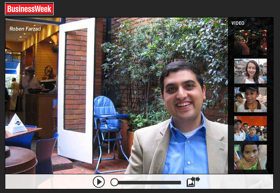
Business news is often about numbers. And when you check the audience numbers on the various top financial news sites online, the portals such as Yahoo Finance and MSN Money come out on top, followed by a jumble of online magazines such as Forbes.com, wire services such as Reuters, and online-only pubs like TheStreet.com.
As of last August, BusinessWeek.com was ranked #13 in unique visitors, according to Nielsen/NetRatings, below Motley Fool and above Financial Times. So how can the old-school publication, published since 1929 by McGraw-Hill, get noticed online when it has to go up against the high-trafficked portals and daily content of the Wall Street Journal and Reuters? The site’s executive editor, John Byrne, told me one of his top goals was to create deeper, more meaningful engagement for his online audience with more blogs, audio podcasts, video reports and aggregating outside content.
After trying to wall off some of its online content for paid subscribers only, BusinessWeek.com changed course and made almost the entire site free of charge in 2006. And over the past year the site was redesigned with an eye on usability and reader interaction. Byrne says that his internal traffic numbers from Omniture show a record half-billion page views for the site in 2007, including 8.9 million unique visitors in October, as well as a soaring number of comments on stories and blog posts.
The site now has 18 blogs and 22 audio podcasts, and a feature called Executive Summary that aggregates outside news sources to give a snapshot of the day’s global business news. The site definitely has a cleaner look, but will all that new online-only content really give BusinessWeek.com a chance to catch the portals’ huge business audiences? And how can the site stand out in the crowd of financial sites online?
“[The portals] are aggregated plays, while we’re delivering original content with voice,” Byrne said. “We have dramatically different audiences because we’re not going for the general consumer but the serious business global professional. As far as the Wall Street Journal, they have more content because they are a daily. We don’t have the manpower to compete in that way, but we can be more of a smart filter and pick and choose the content to make us a businessperson’s personal consultant. And if they trust our judgment then there’s value in that.”
BusinessWeek.com is also trying to change the way its print and online staff work together, and is trying to get its reporters and editors to interact more with readers. The various assistant managing editors for the magazine have now been given responsibility for both their print and online sections, similar to an integration that happened at the New York Times starting in 2005. Plus, Byrne has promised that he will lead by example, mixing it up with readers in online forums in the hopes that other staffers will follow his lead. (For more on how BusinessWeek.com and other traditional media publications are dealing with comments and forums online, see last week’s feature on MediaShift.)
Byrne believes that if Rupert Murdoch opens up the Wall Street Journal Online and makes the content free of charge, it will be “checkmate” against Yahoo Finance, the current leader in traffic for financial sites. But Byrne is more mysterious about BusinessWeek’s chances of catching the portals, telling me BusinessWeek has “a strategy to significantly scale and we’ll soon be able to talk about exactly how that will happen.”
The following is an edited transcript of my wide-ranging phone conversation with Byrne.
Tell me some of the highlights of the past year as you’ve revamped the site’s navigation and design.
John Byrne: We launched new channels, including the Company Insight Center. It is a database of financial and executive information, and you can search for companies and see financial results, a listing of the top executives and their bios, who’s on the board of directors, and so on. When we put it on the site, it tripled the number of pages available to our readers because there are over 350,000 companies in the database.
That’s been a huge success for us for a number of reasons. One is that it uses the web for what it does best. It’s not traditional journalism, it’s simply data that anyone can go in and get free, where previously they would have to pay for that information. It’s attracting a huge amount of traffic for us.
Then we launched a Managing Channel with interactive case studies. There would be a statement of a problem, a video of the protagonist involved in the problem, a video of an analyst giving their view, and a poll of the readers saying whether they agree or disagree with the solution. And then an open discussion by the readers to engage in the problem.

We’re also offering more analysis on breaking business news, with aggregated roundups. If something’s breaking, we’ll do a story rounding up the valuable insight on it from around the web and do a summary on it. We also will do a fast-track video. If we want to get something up quickly and a writer doesn’t have time to put together a magazine-style piece, we have them do a video. We are doing one of two things: either we put a videocamera in the writer’s cubicle, and have the writer give perspective on the story and put the video up along with an AP story; or we’ll have the writers blog about it and will surface those blog posts as news stories on the home page.
How are you getting people to participate more on the site?
Byrne: We have had a very rigourous, very lively reader involvement on the site for a long time. In any given month, roughly 15,000 people participate in conversations on our site, but they are largely hidden from view. You have to either go into a blog and see how people are responding, or you have to go into a forum to see how people are exchanging views, or go to the end of a story to see the comments on it. We want to elevate those conversations and make them more apparent to everyone that these conversations are occuring.
We are rewarding our readers for making thoughtful comments on our site by going to the reader and saying, “We like what you’re saying and want to feature it in a prominent way, can you send us a digital picture of yourself so we can put it on the home page.”
This is about elevating our conversation and giving credence to the rhetoric that everyone has, that the web is a dialogue and not a lecture. The truth is that very few people are delivering on it, having reporters actively engage with readers or elevating comments and saying, “This is as important as any story we have, any video we have, any audio we have.”
We closed the year with records in uniques and page views and comments on the site [for the whole year]. For 2007, comments on stories was up 29%. The number of people actually posting on stories was up 19%, and that doesn’t include comments on blogs or forums. In November, we had a record number of page views and in October we had record numbers for uniques. And for the year we surpassed a half billion in page views for the first time.
Why did you have those record numbers?
Byrne: It reflects on the growth of the web, and it reflects on the new features we’ve added, including the Company Insight Center. We’re also getting better at it, now that the site has one unified look and our efforts in search engine optimization. Our #1 referral site for the first time was Google. If you were to type into Google, the stock ticker for Microsoft [MSFT], we come up before even the company’s site comes up, as the #2 result. We’ve really optimized the site for search and have really added a lot more features and content, and cleaned it up so it’s much more accessible to the reader.

The conventional wisdom is that video is taking off and that audio podcasts are dead. We surpassed one million audio podcast downloads every month last year, and we have more podcast downloads in any given month than subscribers to our magazine. And the reach of our site in any given week is double the magazine’s reach.
Online, it sounds like everything is going up, while everything on the print side is going down, in terms of circulation and ad pages. Where do you stand when it comes to this transition stage where you get more attention online, being a multi-platform news organization and not print-centric anymore?
Byrne: Clearly ad revenue is down on the magazine side, and ad revenue is clearly up online…We’ve taken an integrated approach instead of an independent approach. Another change that just occured is that all the assistant managing editors at the magazine who had only worked for the magazine, as of this month they work for online and the magazine. The assistant managing editors have been given areas of coverage like corporations, technology, news and each one is responsible for online and print. We tasked the senior management who had been with the magazine with online responsiblities so that they have to think about both constantly.
As it has been, the magazine staff has been producing roughly half their work for the web. For the year before last [2006], 52% of all the published words produced by the average magazine writer was online and not in print — that’s for magazine journalists. I can’t imagine it getting any higher. That workload occured without the latest move that will get us important management bandwidth that we hadn’t seen. What we’ll see is more analytical stories off breaking news and more online enterprise than we’ve had. But we’ve done a number of online enterprise stories, including some narrated slide shows, which is new and a very big and important feature. They include video, still photography and voiceovers and they are beautiful pieces of journalism.
We had two cover stories on emerging markets, one on Colombia and one on Africa. The reporter who did the story on Africa, Roben Farzad, brought a videocamera and still camera with him, and did four slide shows, three of which are narrated. Within each slide show, there are four clips of video and the narration is very compelling, as though you were sitting in a bar next to a person who’s telling you about his trip. It’s kind of like a business travelogue. For Farzad, those narrated slide shows were more work than the cover story for the magazine.
So how do they feel about doing those? Are they overwhelmed with having to do that extra work?
Byrne: This is the same guy who did the cover story on Colombia, and when he did the narrated slide show with that story, he got more reaction, more feedback, more reader engagement from this one slide show than he did from the cover story. So when he went to Africa that’s why he wanted to do four slide shows instead of one. He was so gung-ho about the way the slide show engaged readers that we didn’t even have to ask him to do it.

Now that’s not everyone. Some people are really good at this and other people don’t get it at all and that’s fine too. In this case it was a beautiful melding of integrated storytelling at its highest level.
I’ve heard management people at MarketWatch talk about having more online discussions, but it’s hard to get reporters or editors to participate.
Byrne: That’s true. Everyone’s time is limited, and there are a lot of pressures that we’ve placed on them. It’s a highly competitive business and some people like [interacting with readers online] and some don’t. What I feel it means is that I have to hold myself more accountable. I’ve got to do it myself and invite people to play, and I have to get involved myself in these dialogues. Because we’re going to surface them every day, I will go in and actively engage with the readers myself and invite my reporters to do the same.
This module on the home page [highlighting the best comments], I see a similar thing on every channel page. So you’ll see one on the Managing Channel, one on the Technology Channel, and the one on the home page will rotate a few times each day. It’s basically allowing the readers to be heroes, which no one else is really doing.
With your focus on participation and engagement, are you looking at how long people spend on the site rather than just visitors?
Byrne: Time spent is not as important to me as making a contribution to the site. I look at it as input and output. In any given month, we probably publish 800 to 1,000 stories on the site and get 15,000 comments in. So that’s about a 15-to-1 ratio and I want to triple that by the end of the year. So for every story we put out, I’d like to have 45 contributions from our readers.
The page views, time spent and visitors metrics don’t really get at the engagement that I’m talking about. Outputs to inputs do. I would say that page views times uniques is mindless engagement, like when someone is passively watching a TV screen but it doesn’t say if they’re doing anything. I want mindful engagement instead of mindless engagement. My definition of that is you have to read something and then go to the trouble to add something useful to that and create a whole new level of discourse on the site. That is engagement, not the other conventional measurements that other people are using.
There was an article in the New York Times about the redesign of BusinessWeek and there was a line in there saying, “the web is hurting business magazines.” Do you see it that way?
Byrne: It’s not about a readership problem, it’s an advertiser problem, and that’s important to note. Generally when people think about web vs. print they think it’s a reader problem but it is an advertiser problem because the advertisers are migrating to the web and other places because they have more places to advertise. To the extent that some industries have slumped, like autos, that’s hurt. To the extent that there’s been widespread consolidation in the technology business means that there are less companies to advertise.
We allowed new players like Yahoo, MSN, and AOL to come into our territory, to develop no content at all and become the dominant players. The incumbents [in business journalism], we have only ourselves to blame in the digital space. Now, I think pretty much all of us have been awoken to the fact that this has happened and now we have to fix it. By fixing it I mean scaling our site and doing what we do best, delivering high quality journalism that’s unique and creative and using the web for what it’s for. The web is all the mediums combined, it’s TV, it’s radio, it’s print and it’s new things as well. It’s not another medium. And it’s up to us now to reclaim what should be our rightful share.
That’s why Rupert Murdoch is going to open up the Wall Street Journal, because it would be a checkmate move against Yahoo Finance. It won’t happen overnight but Yahoo Finance can’t beat the Wall Street Journal’s content.
*****
What do you think of the BusinessWeek.com site? What do you think are its strengths and weaknesses vs. the business portals and other financial sites online? Can business magazines in general make the shift online as their print ad sales slump? Share your thoughts in the comments below.
UPDATE: I received an email from Dan Gillmor, director at the Knight Center for Digital Media Entrepreneurship at Arizona State University, who disagreed with Byrne’s view of a Dow Jones “checkmate” over Yahoo Finance:
Unless WSJ [Wall Street Journal] is prepared to be an aggregator in a dramatic way, this is hardly checkmate. Good as the WSJ/DJ material is, it’s not all there is — to the extent that Yahoo Finance points to everything else and sparks valuable conversations about the issues/companies, it has a great future.
UPDATE 2: Weird timing but two interesting things just came out today that relate to this blog post. According to WSJ.com’s Daily Davos blog, Rupert Murdoch has said that he will not lift the pay wall at WSJ.com, but increase the amount of free content and make the pay content even pricier.
Also, McGraw-Hill, the owner of BusinessWeek, just released its fourth-quarter earnings, including these two salient points noted by PaidContent:
> Ad revenue at BusinessWeek.com grew 10.5% in the quarter and 14.8% for all of 2007.
> Print ad pages at BusinessWeek fell by 21.8% in the quarter and 18.2% for the year.
These numbers are not good. The online ad growth lags behind the rest of the online advertising world, where growth has been in the 20% to 30% range. And the drop in print ad pages is accelerated from the 12.6% drop in ad pages for the first half of ’07.
UPDATE 3: I heard from the editor in chief of MSN Money, Richard Jenkins, who disputes the line by Byrne about portals developing “no content at all.” Jenkins says that it’s a common misconception about portals, but that MSN Money has a big staff creating a ton of original content. Here’s part of his email to me:
I have a staff here and across the United States of about 50 people, including several contributing writers who are under long-term contract, such as Liz Pulliam Weston. My own experience includes 17 years in newsrooms, my last seven at the L.A. Times. Among my senior editors, I have a veteran editor from Worth Magazine (Jim Jubak), the Wall Street Journal (Chris Oster), the Seattle Times (Desmond Toups) and the Newark Star-Ledger and The Record (Art Lenehan). All together, MSN Money’s permanent full-time staff has editorial experience amounting to more than 300 years.
About two-thirds of the content that we publish is original, and it’s one of the main reasons that MSN Money has remained the No. 2 Web site (per Nielsen/NetRatings) for the past five years. Total editorial page views grew 80% from 732 million in 2006 to 1.3 billion in 2007. Over the past five years, we’ve earned one Loeb award, a bronze medallion from the Society of Professional Journalists, four awards and certificates from the Society of American Business Writers and Editors and one from the Online News Association, and two Clarion Awards from the Association for Women in Communications.
[Original content] has been a fundamental pillar of our competitive offering since I launched the original Money Insider site in 1997, and it is arguably the most successful aspect of our site.

Publications like BusinessWeek, which seek to serve the busy professional, should assume that the online experience will be through gadgets, such as the iPhone, Blackberry and whatever is to follow.
BW should strive to become the one business publication DESIGNED for use on the go. This will be a point of differentiation for readers as well as advertisers.
Great article. It was informative and engaging. I came across this article, through newstrust.net. I enjoyed reading the behind the scenes perspective from the Executive Editor at Businessweek.com and your synopsis of the competitive landscape of online news giants. Kudo’s to the entire team responsible for creating the Media Shift weblog. The design, platform, wrting, wealth of information is a must read online resource for anyone interested in new media. Keep up the good work. The Media Shift Blog is awesome!!!
Echo Juliet’s comment. I’m from the UK and there are lots of “takeaways” from this case study for UK B2B publishers.